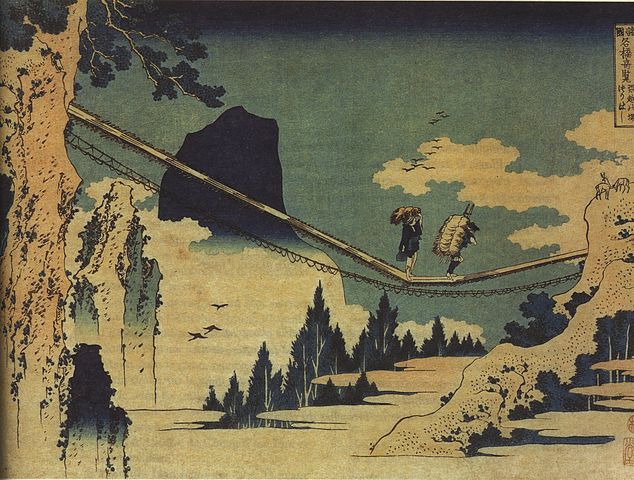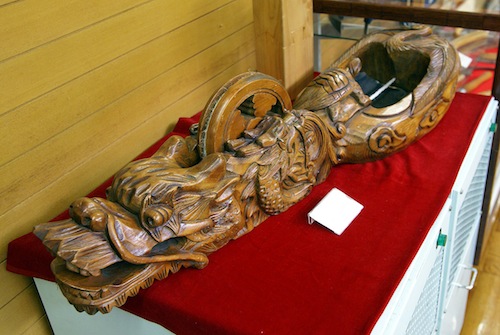The Importance of Being Earnest
Let's start with a quiz. What natural shape would you choose if you wanted to symbolize "earnestness"?
a. a river in which the rapids bubble up and over rocks in an effort to reach the next spot
b. a cedar tree that grows straight and tall
c. a mountain that stands firm and immovable
d. the sun, for the steadfast, intense way in which it burns
The answer appears after the picture.

"Gate of Bishamonten," a work by Masao Maeda.
The answer:
b. a cedar tree that grows straight and tall
I'm referring to this saying:
心の杉 (こころのすぎ) mind, heart + cedar
This phrase refers to an honest and sincere mind, deriving from the way a cedar grows straight. Furthermore, because the tree is evergreen, people use 心の杉 to describe an earnest, singleminded person who remains constant.
Of course, not everything in our lives comes from the natural world. Let's play the same game, this time with a range of choices from the manufactured world. Which of these objects would you associate with something earnest?
a. a computer, which produces results objectively with no human bias
b. a flagpole, which remains firm and straight in all types of weather
c. a device with which a carpenter makes a straight line
d. a train in Japan, which tends to arrives right on time, down to the second

Here's a time when you would long for something straight! This woodblock print by Hokusai is called 飛越の堺つりはし (ひえつのさかいつりはし: Suspension Bridge at the Boundary between Hida and Etchu), where 飛 and 越 are short for 飛騨 (ひだ) and 越中 (えっちゅう), respectively. The bridge, which connects Gifu and Toyama Prefectures, apparently still exists; see the first two photos at the link.
The answer:
c. a device with which a carpenter makes a straight line
I'm talking about this type of instrument:
As essay 1821 on 墨 (black inkstick; black ink) explains, this gizmo contains a silk thread that’s saturated with black ink and wound on a pulley inside. A carpenter pins the thread down on one end of a timber, stretches the thread along the wood, and causes the inked thread to snap against the board. As it does so, it creates a reference line. One site explains the process in more detail. Carpenters refer to this procedure as follows:
墨掛け (すみかけ: procedure for marking a line with an inked string) ink + to put on
The device goes by the following word (in which the second kanji is non-Joyo):
墨壺 (すみつぼ: ink pad; carpenter’s inking device) ink + jar, pot
However, people often call the instrument a 墨縄 (すみなわ), which is one term for the silk string that plays the starring role. That word appears in this sentence:
大工が墨縄を打った。
The carpenter marked the line on the timber with inked string.
大工 (だいく: carpenter); 打つ (うつ: to shoot)
Did you notice the verb? When referring to the act of marking lines on wood, the Japanese use the verb 打つ (うつ: to shoot) because the marked line is so straight and long that it’s as if it has been shot from a gun!
People stopped using this tool around the 1990s, when a new device appeared, one that involves laser beams instead of strings. What a shame. Nevertheless, this concept lives on in various ways, including in this old tanka by an unknown author:
かにかくに 物は思はず 飛騨人の 打つ墨縄の ただひと道に
I will not fall in love with this person or that. I will go on this one single road of love
(I will singlemindedly love this one person), which is as straight as an ink line drawn by a Hida carpenter.
かにかくに (this or that; one way/thing/person or another); 物 (もの: thing); 思はず (not to think (about));
飛騨人 (ひだびと: people of Hida); ただ (straight); ひと道 (ひとみち: 1 road with no alternatives)
Because this poem is old enough to have been included in the 8th-century poetry anthology known as the 「万葉集」 (まんようしゅう), little here corresponds to Modern Japanese. Nearly all the yomi and definitions require special explanations. For instance, this 墨縄 has the written yomi of すみなは, but we need to read it aloud as すみなわ. And it makes most sense to define 物は思はず as a unit meaning "not to think of someone" or "not to fall in love." Also, we need to read the 思はず as おもわず.)
But I want to walk a "single road" right now, sticking to one point: This poem conveys how earnestly the poet cares about someone. The feeling is as sincere as the straight inked lines created by carpenters from Hida, an old province (now called Gifu Prefecture on Honshu) that was famous for its excellent carpenters.
In this poem, ひと道 does the bulk of the work. In Standard Japanese, this word would be 一筋 (ひとすじ). However, you write it, this term can have the following definitions:
• one long, straight object (e.g., strand of hair, beam of light)
• earnest, intent, devoted
(Actually, it can also mean "single bloodline" and "ordinary; common," but we'll ignore that on our single road!)
In the poem, ひと道 conveys both meanings. How clever and efficient! And how unexpected for English speakers. But as we saw with the cedar tree, the Japanese associate straight lines with earnestness. It therefore amuses me that in an illustration accompanying this tanka, the inked string of the carpenter's device is as curly as can be!
Linking straightness to sincerity actually isn't unheard of in English. We prefer "straight shooters" to "devious" people (though I've found that people aren't thrilled when you keep it too real!). We say we want others to be "straight" with us (but again don't trust this request blindly!). No one likes a "forked tongue," though that could have to do with a widespread fear of snakes.
Do we, however, have a symbol for "earnestness"? All I can think of are George Washington (who could not tell a lie) and Honest Abe. It seems that the best things English can offer in this respect are dead presidents!
Clearly, the Japanese have a leg up the cedar tree when it comes to earnestness, so I'll introduce one more Japanese term that unexpectedly means "earnest":
切ない (せつない: painful; trying; heartrending; sad; distressing; having something wring out one's heart)
I first heard this last year when I told my language partner Kensuke-san how hurt I felt by an old friend who didn't seem to care about me anymore. Kensuke-san listened with great concern and pronounced the situation 切ない.
I wondered about the presence of 切 in this word. What was being cut? Heartstrings? The connection between two people? But then again, the term ends with -ない, so what was not being cut?
I later asked my proofreader about 切ない. It essentially means "painful," he said, but with a great deal of sentimental connotation. It refers to such feelings as sorrow, loneliness, or longing that are so strong that you actually feel pain in the heart. He said that the Japanese describe that kind of feeling this way:
胸が締め付けられるような
as if one's chest/heart were squeezed
胸 (むね: chest); 締め付ける (しめつける: to tighten)
In 切ない, he said, the -ない is a suffix meaning "very," rather than "not" or "no." This -ない attaches to the root of an -い or -な adjective, exaggerating the original meaning.
As for the first half of the word, 切 (せつ), he explained that this is the root of the archaic -なり adjectival form that's equivalent to today's -な adjective. That is, in the olden days, people used the term 切なり (せつなり: earnest, ardent). Now the Japanese instead use these two forms:
• 切なる (せつなる: earnest, ardent), which looks like a verb but is actually an adjective that modifies nouns, as in 切なる願い (せつなるねがい: earnest hope)
• 切に (せつに: earnestly, wholeheartedly), which is an adverb, as in 切に願う (せつにねがう: to hope wholeheartedly)
Originally, he noted, 切ない referred to wholehearted feelings, positive or negative. Nowadays, people use 切ない exclusively for negative ones. This word is particularly appropriate when someone thinks of something or someone wholeheartedly but has a wish that never comes true.
Still, positive interpretations of 切 as せつ persist. It can mean "thinking of something or someone as very important." This positive flavor informs such terms as 親切 (しんせつ: kindness) and 大切 (たいせつ: important).
Important? Ah, between 大切 (important) and 切なる (earnest), 切 can give us practically the whole title The Importance of Being Earnest!
The single road turned out to be long! It was a lot simpler to convey earnestness with the minimalistic 心の杉. That brings me to the essay of the week, which is on 杉 (cedar):

Have a great weekend!


Comments